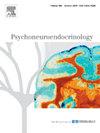Placental epigenetic age: Associations with prenatal maternal psychosocial adversities and preschool emotional and behavioral problems
IF 3.6
2区 医学
Q2 ENDOCRINOLOGY & METABOLISM
引用次数: 0
Abstract
Background
The link between prenatal psychosocial adversity and offspring behavioral problems is well-established; however, the underlying pathways are still being explored.
Methods
Data was a random sample from the Shanghai Maternal-Child Pairs Cohort including women enrolled at early pregnancy and followed children 3–6 years old. The current study comprised 82 mother-offspring dyads based on the availability of placental DNA methylation. A cumulative number of maternal psychosocial adversities was the primary exposure, including socioeconomic, mental conditions, behavioral lifestyle, and physical disorders. Individual adversity components were analyzed as secondary exposures. Placental epigenetic age acceleration (EAA) derived from the difference between epigenetic age and gestational age at birth. Emotional and behavioral problems for preschool children were assessed by the Strengths and Difficulties Questionnaire.
Results
Mothers who faced two to four psychosocial adversities, or at least five adversities, exhibited 1.51 weeks (95 % CI: 0.66–2.36) and 1.67 weeks (95 % CI: 0.87–2.47) of EAA, respectively, compared to those without or one adversity. Maternal prenatal high-level stress, depression symptoms, occupational hazards, poor sleep quality, GDM were associated with placental EAA. Placental EAA was positively associated with preschool greater emotional and behavioral problems, especially in boys. The mediated proportion of EAA was 13.8 %, 21.3 % for the association of psychosocial adversities with total difficulties and internalizing problems.
Conclusion
Prenatal maternal psychosocial adversities would accelerate placental epigenetic age, which would increase preschool emotional and behavioral problems.
胎盘表观遗传年龄:与产前母亲社会心理逆境和学龄前情绪和行为问题的关系
产前社会心理逆境与后代行为问题之间的联系已得到证实;然而,潜在的途径仍在探索中。方法数据来自上海母婴对队列随机抽样,包括早期妊娠妇女和3-6岁儿童。基于胎盘DNA甲基化的可用性,目前的研究包括82对母子二代。母体社会心理逆境的累积数量是主要暴露,包括社会经济、精神状况、行为生活方式和身体障碍。个体逆境成分作为二次暴露进行分析。胎盘表观遗传年龄加速(EAA)源于出生时表观遗传年龄与胎龄的差异。采用优势与困难问卷对学龄前儿童的情绪和行为问题进行评估。结果面对2 ~ 4个逆境或至少5个逆境的母亲的EAA表现分别为1.51周(95 % CI: 0.66 ~ 2.36)和1.67周(95 % CI: 0.87 ~ 2.47)。孕妇产前高应激、抑郁症状、职业危害、睡眠质量差、GDM与胎盘EAA相关。胎盘EAA与学龄前儿童的情绪和行为问题呈正相关,尤其是男孩。心理社会逆境与总困难和内化问题的关联中EAA的中介比例分别为13.8 %和21.3 %。结论产前母亲社会心理逆境会加速胎盘表观遗传年龄,增加早产儿的情绪和行为问题。
本文章由计算机程序翻译,如有差异,请以英文原文为准。
求助全文
约1分钟内获得全文
求助全文
来源期刊

Psychoneuroendocrinology
医学-精神病学
CiteScore
7.40
自引率
8.10%
发文量
268
审稿时长
66 days
期刊介绍:
Psychoneuroendocrinology publishes papers dealing with the interrelated disciplines of psychology, neurobiology, endocrinology, immunology, neurology, and psychiatry, with an emphasis on multidisciplinary studies aiming at integrating these disciplines in terms of either basic research or clinical implications. One of the main goals is to understand how a variety of psychobiological factors interact in the expression of the stress response as it relates to the development and/or maintenance of neuropsychiatric illnesses.
 求助内容:
求助内容: 应助结果提醒方式:
应助结果提醒方式:


